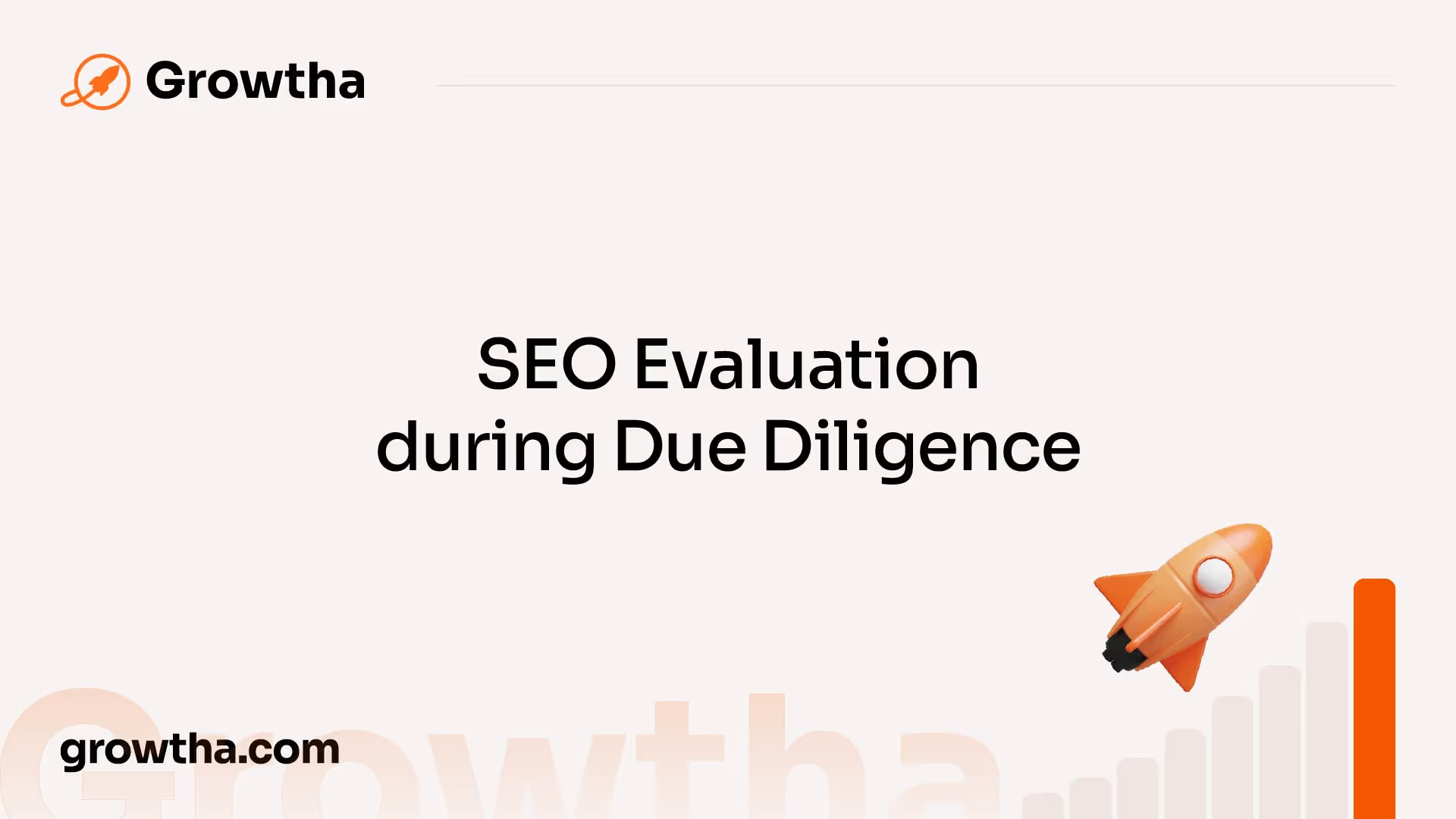The Role of SEO in Mergers and Acquisitions
When it comes to mergers and acquisitions (M&A), SEO plays a crucial role in ensuring a smooth transition and maximizing the benefits of the deal.


The Role of SEO in Mergers and Acquisitions
The Role of SEO in Mergers and Acquisitions

When it comes to mergers and acquisitions (M&A), SEO plays a crucial role in ensuring a smooth transition and maximizing the benefits of the deal. In this section, we will explore the impact of acquisitions on search visibility and the process of identifying acquisition targets.
Impact of Acquisitions on Search Visibility
Acquisitions can have a significant impact on search visibility, leading to new leads and business growth as websites are merged. For example, acquiring an expired domain of a top HVAC company resulted in top rankings for many main terms practically overnight. This boost in search visibility can bring increased organic traffic and potential customers to the acquiring company's website.
By acquiring established websites or domains that have already built authority and search visibility, companies can benefit from an immediate advantage in the search rankings. This can result in increased brand exposure, higher click-through rates, and ultimately, more conversions. It is essential for companies involved in M&A to consider the impact of these acquisitions on their overall SEO strategy to leverage the full potential of the deal.
Identifying Acquisition Targets
In the process of M&A, SEO professionals can play a crucial role in identifying potential acquisition targets. By analyzing organic search traffic, competitive landscape, and market evolution, SEOs can help identify websites or domains that align with the acquiring company's goals and objectives. Tools like the Organic Competitors report in Site Explorer and Traffic share by domain report in Keywords Explorer can provide valuable insights during this analysis process.
Before the due diligence process, SEOs can run checks to evaluate the traffic trends, history of search engine updates issues, and forecast future traffic performance of potential acquisition targets. This evaluation helps in assessing risks and potential valuation impact, allowing companies to make informed decisions during the acquisition process.
By involving SEO professionals early in the M&A process, companies can ensure that they are targeting acquisitions that align with their SEO goals and have the potential to enhance their search visibility. This strategic approach can lead to a smoother integration process and maximize the overall benefits of the M&A deal.
Incorporating SEO in Due Diligence

During the process of mergers and acquisitions (M&A), it is crucial to incorporate SEO considerations into the due diligence phase. This helps in assessing the potential impact on search visibility and evaluating the acquisition targets effectively. There are two key aspects to consider: pre-due diligence checks and SEO evaluation during due diligence.
Pre-Due Diligence Checks
Before proceeding with the formal due diligence process, SEOs can conduct pre-due diligence checks to gather valuable insights about potential acquisition targets. These checks involve evaluating various aspects related to SEO performance and risks.
One important aspect is assessing traffic trends and historical issues related to search engine updates. By analyzing the target's traffic patterns, SEOs can gain insights into the growth potential and identify any red flags that may impact the valuation of the acquisition target [1]. It also helps in understanding the target's overall visibility and performance in search engine results.
Additionally, SEOs can evaluate the link profile of the target. This involves analyzing the quality and quantity of backlinks pointing to the target's website. A thorough evaluation of the link profile provides insights into the target's reputation, authority, and potential risks associated with link acquisition strategies.
SEO Evaluation during Due Diligence

As the due diligence process proceeds, SEO evaluation should be an integral part of the assessment. This evaluation involves a comprehensive analysis of the target's digital marketing assets, including their website, branding, and other online presence.
During the evaluation, SEOs consider factors such as the target's organic search performance, keyword rankings, and overall SEO health. This analysis helps in assessing the target's current SEO strategy and identifying potential risks or opportunities that may arise from the acquisition.
Moreover, as part of the digital due diligence, the acquirer should evaluate the target's digital marketing tools and technologies. This includes assessing the compatibility, scalability, and monetary value of any third-party applications or systems used by the target. A thorough evaluation ensures smooth integration and alignment of marketing goals post-acquisition.
By incorporating SEO considerations into the due diligence process, acquirers can gain a better understanding of the target's digital presence, evaluate potential risks and opportunities, and align marketing strategies for a successful merger or acquisition. It ensures that the impact of SEO on the overall business performance is taken into account, leading to informed decision-making and optimized outcomes.
Post-Acquisition SEO Strategies

Once a merger or acquisition has taken place, it is crucial to implement effective post-acquisition SEO strategies to ensure a smooth transition and maximize the value of the acquisition. Two key areas to focus on are traffic monitoring and content migration, as well as redirect management and knowledge transfer.
Traffic Monitoring and Content Migration
Post-acquisition, it is important for SEO professionals to closely monitor changes in website traffic. This involves analyzing traffic patterns, identifying any fluctuations, and taking necessary measures to maintain or improve search visibility. By monitoring traffic, SEOs can quickly identify any issues that may arise during the transition process and implement appropriate solutions to mitigate them.
Another crucial aspect of post-acquisition SEO is content migration. It is essential to ensure the successful migration of content from the acquired website to the acquiring website. This process involves mapping out the content on both websites, determining the best approach for content consolidation or restructuring, and implementing the necessary redirects to maintain SEO value. Implementing a comprehensive 301 redirect plan is crucial when sunsetting a website during a merger. Redirecting each page to its most closely related page on the new website ensures a seamless user experience and preserves SEO value [4].
Redirect Management and Knowledge Transfer
Redirect management is a critical aspect of post-acquisition SEO. Properly implementing and managing redirects ensures that users and search engines are directed to the correct pages on the acquiring website. This helps to preserve organic search rankings and prevent users from encountering broken links or error pages. SEO professionals should carefully plan and execute a comprehensive redirect strategy to minimize any negative impact on search visibility and user experience.
Additionally, knowledge transfer plays a vital role in the success of post-acquisition SEO efforts. SEO professionals should facilitate the transfer of knowledge and best practices between the acquiring and acquired companies. This includes sharing insights, strategies, and techniques that have proven successful in driving search visibility and organic traffic. By transferring SEO knowledge, the acquiring company can leverage the expertise of the acquired company and ensure a smooth integration of SEO efforts.
By focusing on traffic monitoring, content migration, redirect management, and knowledge transfer, SEO professionals can contribute to the success of post-acquisition SEO strategies. These strategies help to maintain or improve search visibility, ensure a seamless transition for website visitors, and maximize the value of the acquisition by leveraging the expertise and assets of both companies.
Enhancing M&A Success with SEO

To maximize the success of mergers and acquisitions (M&A), incorporating SEO strategies is crucial. By focusing on a grounded approach and strategic alignment, as well as leveraging external expertise, companies can gain a competitive advantage in the ever-evolving digital landscape.
Grounded Approach and Strategic Alignment
A grounded approach to SEO in M&A involves deep technical knowledge, consistency, and alignment with strategic goals. By integrating SEO efforts into the overall M&A strategy, companies can boost brand value and return on investment (ROI).
When approaching SEO in M&A, it's important to conduct a comprehensive analysis of both the acquiring company and the target company. This analysis should evaluate their respective online presence, including website performance, keywords, and backlink profiles. By doing so, companies can identify areas of opportunity for optimization and develop a roadmap for merging the SEO efforts of both entities.
Strategic alignment is vital in ensuring that SEO efforts are integrated seamlessly into the M&A process. By aligning SEO objectives with the overall business objectives, companies can prioritize efforts and allocate resources effectively. This alignment also helps in minimizing any disruption to organic search rankings and maintaining a consistent online presence during the transition.
Leveraging External Expertise
Incorporating SEO into M&A can be a complex task that requires specialized knowledge and experience. Leveraging external expertise in M&A SEO and due diligence can be a cost-effective alternative to building these capabilities in-house.
External specialists bring a wealth of experience to the table, providing insights and opportunities that might otherwise remain undiscovered. These specialists understand the intricacies of M&A SEO and can navigate the unique challenges that arise during the process. They can also provide guidance on best practices, effective strategies, and industry trends, ensuring that SEO efforts are at the forefront of digital marketing initiatives.
Working with external experts allows companies to tap into a pool of knowledge and resources without the need for extensive training or trial and error. This not only saves time and effort but also enhances the overall effectiveness of SEO in M&A. By leveraging external expertise, companies can optimize their SEO strategies and achieve the desired results with confidence.
By adopting a grounded approach, aligning SEO efforts with strategic goals, and leveraging external expertise, companies can enhance their M&A success through effective SEO integration. These strategies not only boost brand value and ROI but also ensure a smooth transition and long-term online success.
Optimizing M&A SEO Efforts
To achieve the best results in M&A SEO (Search Engine Optimization), it is crucial to optimize efforts and maximize return on investment (ROI). This section explores two key aspects of optimizing M&A SEO efforts: effective ROI strategies and integration with technology and trends.
Effective ROI Strategies
In order to make the most out of M&A SEO efforts, it is essential to identify and implement effective ROI strategies within the framework of mergers and acquisitions. This optimization allows companies to develop a highly efficient M&A marketing and due diligence framework, maximizing value creation while minimizing resource usage.
By focusing on ROI, companies can ensure that their M&A SEO efforts are aligned with their strategic objectives and produce tangible results. This involves setting clear goals, tracking key performance indicators (KPIs), and regularly assessing the effectiveness of the SEO strategies implemented.
To optimize ROI in M&A SEO, it is important to leverage data-driven insights and make informed decisions based on empirical evidence. This precision-driven approach, combining detailed data analysis with innovative strategies, leads to unmatched outcomes [5]. By challenging established ideas and employing novel tactics, companies can facilitate significant growth in their M&A projects.
Integration with Technology and Trends
In the dynamic landscape of mergers and acquisitions, it is crucial to integrate SEO and due diligence efforts with the latest technology and consumer trends. This integration ensures that M&A initiatives are compliant, visible, and impactful. By staying up-to-date with technological advancements and understanding consumer behavior, companies can adapt their M&A SEO strategies to meet evolving market demands.
The integration of SEO and technology allows companies to leverage emerging tools, platforms, and methodologies to enhance their M&A SEO efforts. This might include utilizing artificial intelligence for keyword research and content optimization, implementing voice search optimization strategies, or leveraging data analytics to gain insights into consumer behavior and search patterns.
Furthermore, staying informed about the latest trends in search engine algorithms, mobile optimization, and user experience can help companies stay ahead of the competition. By aligning M&A SEO efforts with these trends, companies can ensure that their content remains relevant and engaging to their target audience.
By optimizing M&A SEO efforts through effective ROI strategies and integration with technology and trends, companies can gain a competitive advantage in their mergers and acquisitions. This commitment to excellence, data-driven decision-making, and innovation sets the stage for successful M&A SEO initiatives that drive business growth.
Website Merging Best Practices
When it comes to merging websites during a merger or acquisition, implementing best practices for SEO is crucial to ensure a smooth transition and maintain search performance. Two key aspects to consider in this process are conducting a search performance audit and implementing content alignment strategies.
Search Performance Audit
A search performance audit is an essential step in the website merging process. It provides valuable insights into the performance of each page and content, highlighting valuable keywords for the sites [3]. By conducting a thorough audit, you can identify the strengths and weaknesses of each website's search visibility and determine the best approach for merging the two sites.
During the search performance audit, it is important to analyze various factors, including:
- Keyword rankings and organic traffic: Identify the keywords that are driving organic traffic to each website and assess their performance. This data will help in deciding which keywords to prioritize during the merging process.
- Backlink profile: Analyze the existing backlinks for both websites to understand their quality and relevance. This information will guide the decision-making process when it comes to redirecting or consolidating backlinks.
- Technical SEO elements: Evaluate the technical aspects of each website, such as site speed, mobile-friendliness, and crawlability. Address any issues that may hinder the merging process and impact search performance.
By conducting a comprehensive search performance audit, you can gain valuable insights into the current state of each website's SEO and develop an effective strategy for merging the two sites.
Content Alignment Strategies
During a website merge, content alignment plays a crucial role in ensuring a seamless user experience and maintaining search visibility. A content audit is essential post-acquisition to evaluate the existing content on both websites and align it with a new content strategy [3]. This involves assessing the relevance, quality, and performance of each piece of content and making informed decisions about whether to keep, kill, or merge the content.
Key considerations for content alignment strategies include:
- Content mapping: Map similar or related content from both websites to identify opportunities for consolidation or repurposing. This ensures that valuable content is not lost during the merging process.
- SEO optimization: Optimize the content for relevant keywords, ensuring that it aligns with the new website's SEO strategy. Update meta tags, headings, and other on-page elements to maintain search visibility.
- Redirects: Implement proper redirects from old URLs to new URLs to preserve search rankings and ensure a smooth user experience. Use 301 redirects to signal to search engines that the old URLs have permanently moved to new locations.
By carefully evaluating and aligning the content from both websites, you can create a cohesive and optimized website that maintains search visibility and provides value to users.
Incorporating a search performance audit and implementing content alignment strategies are essential steps in the website merging process during mergers and acquisitions. By following these best practices, you can ensure a successful transition, maintain search performance, and set the foundation for future SEO success.
References
[1]: https://ahrefs.com/blog/seo-for-mergers-acquisitions/
[2]: https://www.progress.com/blogs/why-due-diligence-companys-digital-presence-crucial-ma-efforts
[3]: https://www.beacondigitalmarketing.com/b2b-marketing-case-studies/flashpoint-case-study-seo-acquisition
[4]: https://www.clarityqst.com/blog/merging-companies-what-to-do-with-web-assets-and-seo/







